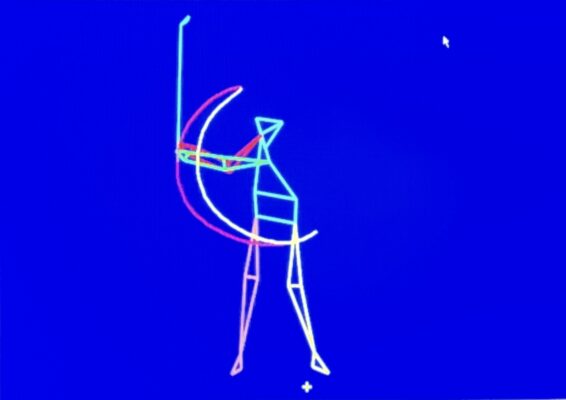
Every golfer, regardless of handicap, has at some point tried to “maintain lag” or “hold the angle” during their downswing. This coveted position—the angle formed between your lead arm and the clubshaft—is not just technical jargon. It’s the ideal swing mechanics behind generating explosive clubhead speed and those extra yards off the tee that we…
Every golfer, regardless of handicap, has at some point tried to “maintain lag” or “hold the angle” during their downswing. This coveted position—the angle formed between your lead arm and the clubshaft—is not just technical jargon. It’s the ideal swing mechanics behind generating explosive clubhead speed and those extra yards off the tee that we all crave.
What Really Causes Power Loss
Many recreational golfers mistakenly believe that extraordinary strength is needed to create and maintain this angle through the downswing. They tense up, trying to muscle the club—which ironically causes exactly what they’re trying to avoid: an early release.
Here’s the truth: Your distance problems likely aren’t due to lack of strength. Rather, it’s about:
The most common power leak? Losing your release angle too early, which not only reduces clubhead speed but brings the club to impact at an inefficient angle—compounding distance loss.
The Attainable Goal
Good news: You don’t need to match Sergio Garcia’s or Min Woo Lee’s dramatic lag positions to add significant distance. When your lead arm reaches parallel to the ground in the downswing, a 45-degree clubshaft angle is both ideal and achievable for most golfers with average strength and coordination.
At this crucial position in the swing, your release angle should be at its maximum. This is your power position.
Key Characteristics of an Effective Release Angle


Analysis of elite golfers reveals these fundamentals:
Common Amateur Mistakes

Backswing Errors:
Downswing Errors:
Practice Makes Power
Try these drills to groove your release angle:
Metronome Tempo Training: Set a metronome to 60 BPM (1 second) and complete your swing (takeaway to impact) within that beat. This promotes the rhythm that allows natural momentum to create proper lag.
Medicine Ball Wall Toss: From setup position, make a backswing motion while holding a 6-10 pound medicine ball, then toss it into a wall. Focus on using your back and shoulders to initiate the toss, creating a wide arc.
Wide-to-Narrow Drill: Start from a mid-backswing position with minimal wrist cock to feel a wide swing arc. As you continue to the top and begin shifting weight to your lead side, allow the clubhead to naturally narrow its arc by coming closer to your body.
Step and Swing: Begin with feet together at address. As your backswing reaches the halfway point, step toward the target with your lead foot while allowing your shoulders and club to complete the backswing. Feel the clubhead accelerate through impact like cracking a whip.
Weighted Club Training: Programs from speedsticks.com or thestacksystem.com offer comprehensive systems to build clubhead speed and increase distance.
You Tube video link: Click here to see a video of how to learn the proper release angle.
The Bottom Line
Remember: Proper mechanics create the ideal release angle naturally. It cannot be forced through effort or manipulation—it must be allowed to happen. Regular practice of these drills will integrate this power source into your swing, giving you those extra yards without sacrificing control.
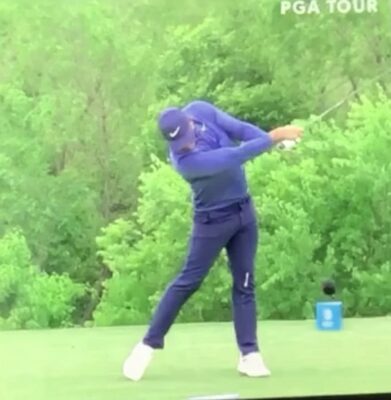
Although you cannot retrieve a shot once it leaves the clubface, the follow-through remains an extremely important part of the full golf swing. More than any other stage of the swing, it offers visual proof of what your body and club did before the ball was struck. Even though there are many idiosyncrasies that make…
Although you cannot retrieve a shot once it leaves the clubface, the follow-through remains an extremely important part of the full golf swing. More than any other stage of the swing, it offers visual proof of what your body and club did before the ball was struck.
Even though there are many idiosyncrasies that make PGA and LPGA players follow throughs their certain style, there are things they do in common that have a direct cause/effect relationship with the movements that transpired earlier in the swing.
The photos below reveal several key swing mechanics of a sound follow-through of PGA professionals:
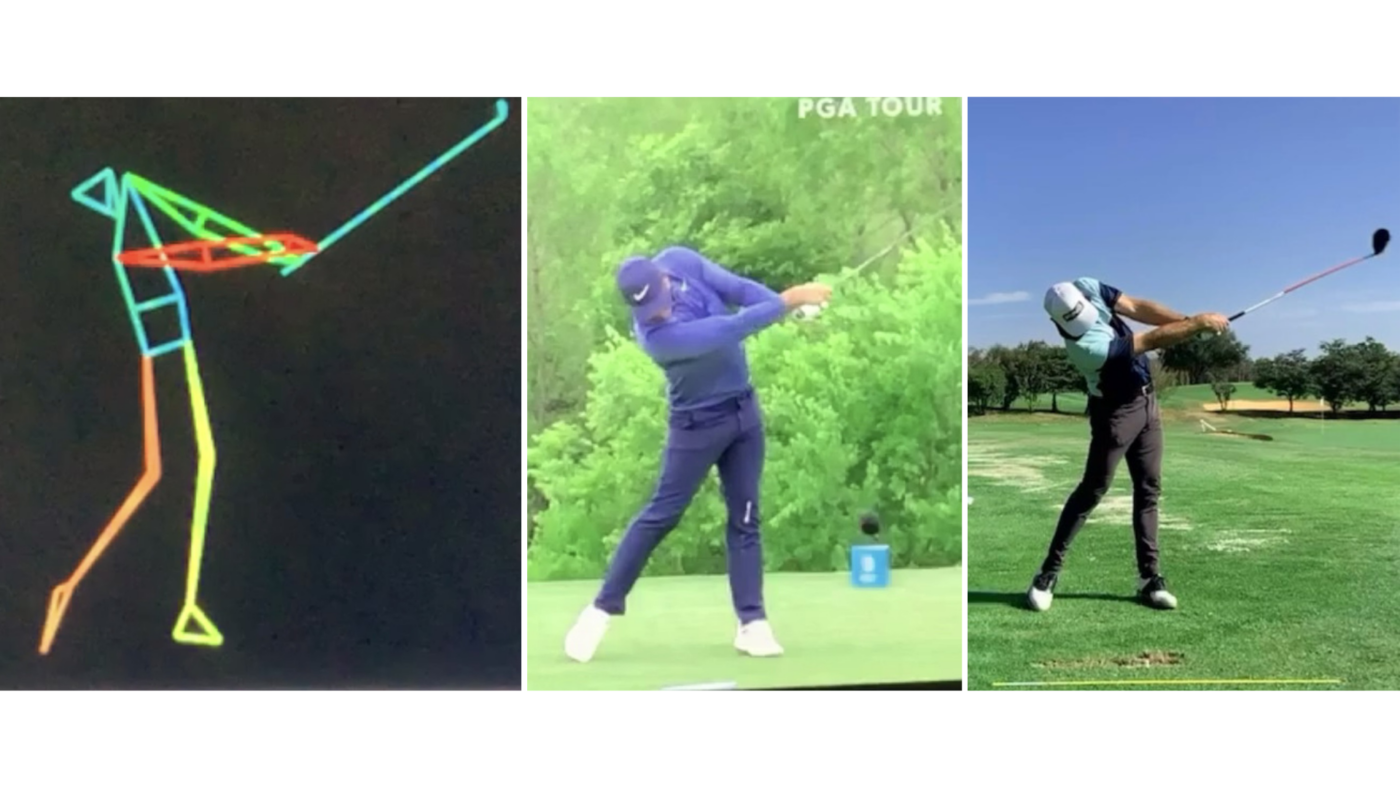
Body Mechanics
Lower Body Dynamics
Upper Body Movement
Arms and Club Position
Arm Extension
Hand and Wrist Position
Photo of common follow-through problems of amateur golfers:
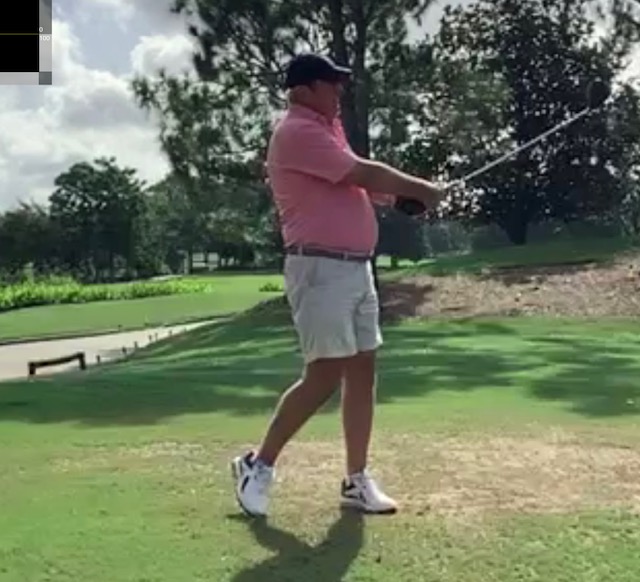
Typical Errors to Avoid
The majority of follow-through positions are a direct result of movement patterns developed earlier in the swing. By learning to engage the right side of your body correctly and allowing your arms to extend naturally, you’ll notice significant improvements in both power and accuracy across all your shots.
Reminder: Avoid consciously manipulating the swing. Instead, focus on developing smooth, natural mechanics that allow momentum to guide your movement.
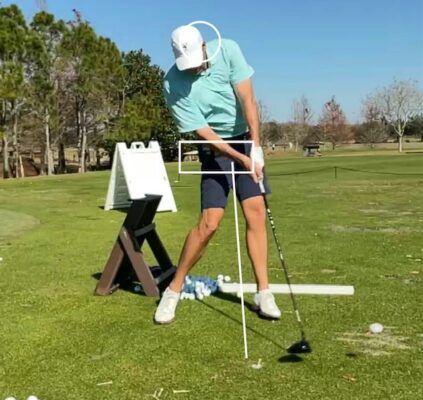
In the golf swing, the impact position represents the critical moment where skill, technique, and power converge. Unlike the static setup, impact is a dynamic, high-speed position that separates exceptional ball strikers from average players. In the accompanying photographs—showing a face-on view and a down-the-target-line view—I compare three golfers at setup and impact: a model…
In the golf swing, the impact position represents the critical moment where skill, technique, and power converge. Unlike the static setup, impact is a dynamic, high-speed position that separates exceptional ball strikers from average players.
In the accompanying photographs—showing a face-on view and a down-the-target-line view—I compare three golfers at setup and impact: a model professional, a scratch amateur, and an eighteen-handicap amateur.
Face-on View Comparisons
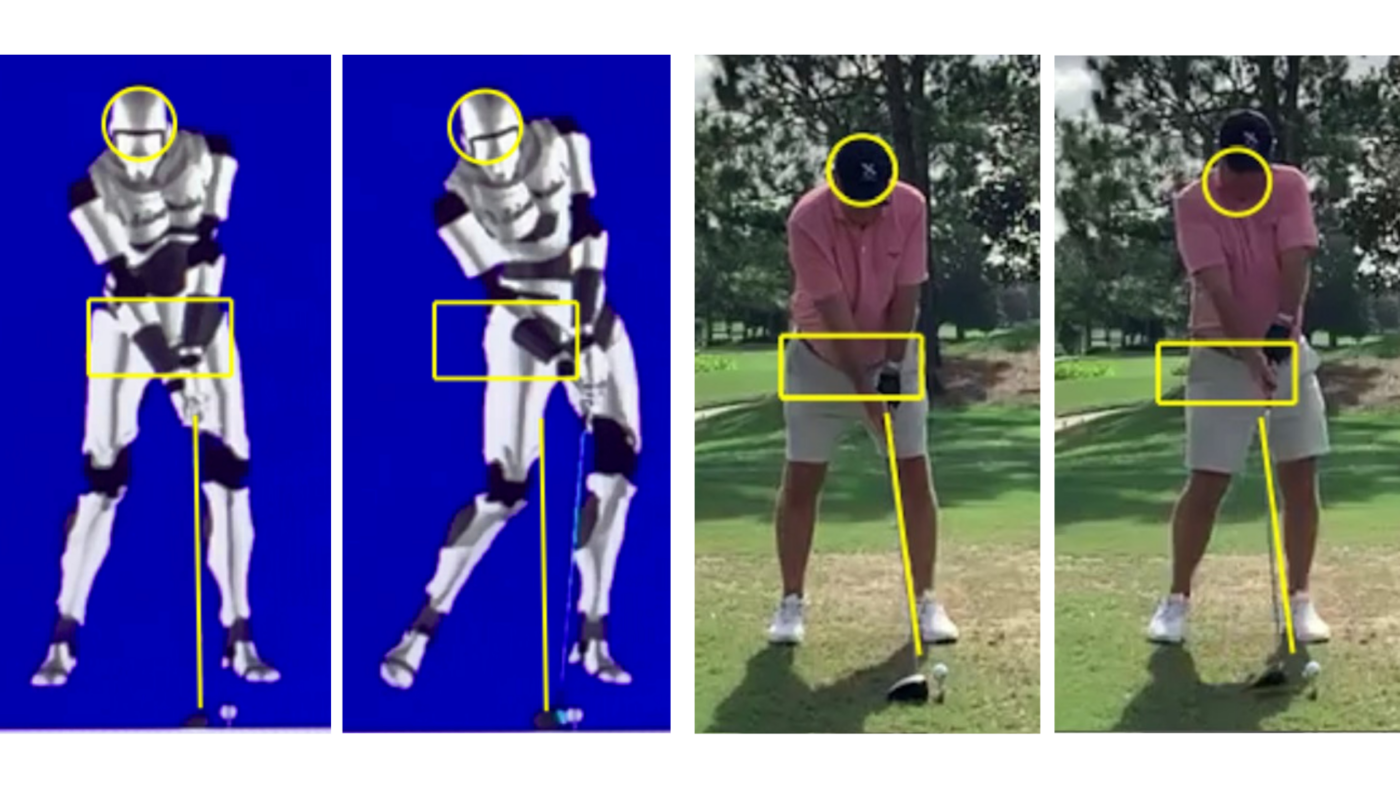
Model pro vs Eighteen-Handicap Amateur
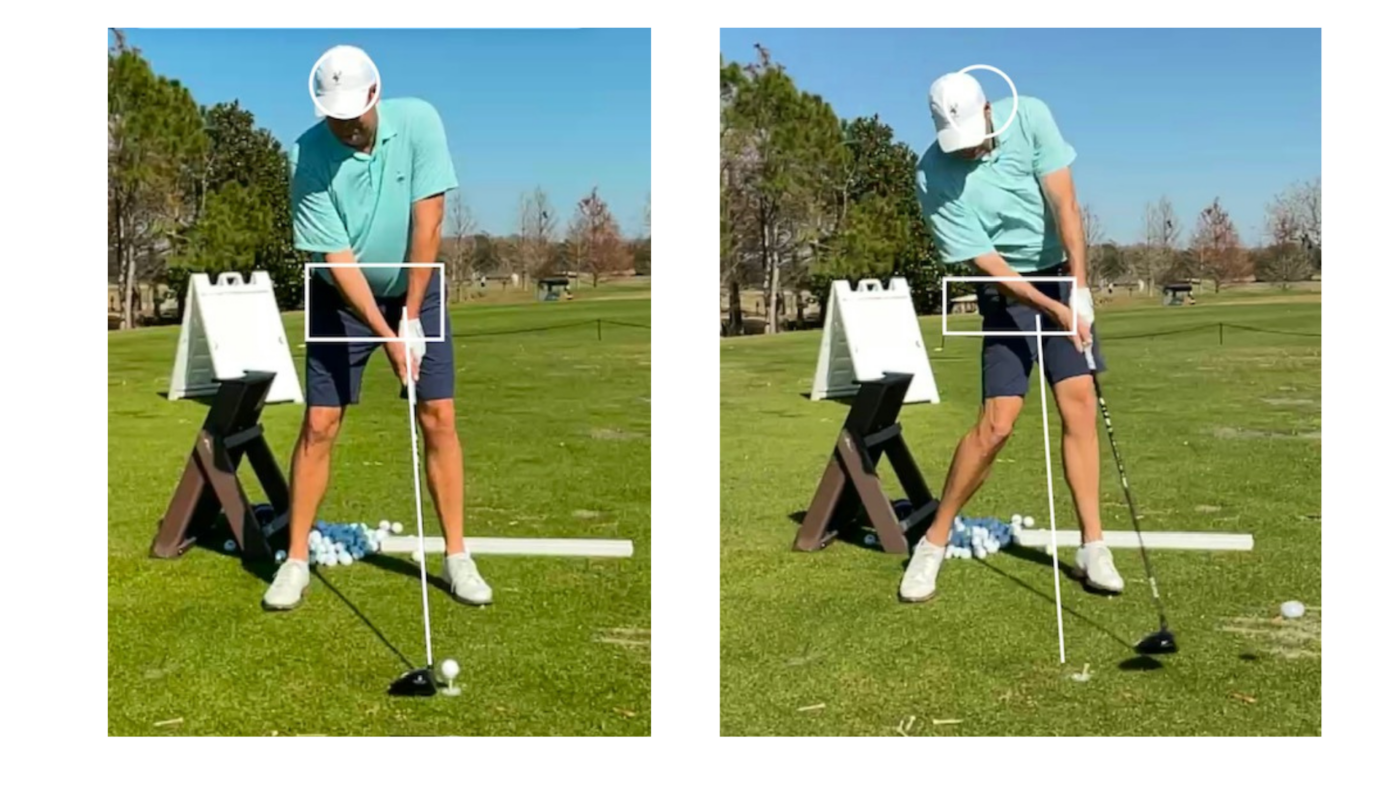
Elite Amateur
Face-on view demonstrates:
Eighteen-Handicap Amateur (Critical Flaws): Face-on View:
Down-the-Target-Line View Comparisons

Model pro vs Eighteen-Handicap Amateur

Elite Amateur
Eighteen-Handicap Amateur (Critical Flaws): Down-the-Target-Line View:
Remember, the perfect impact position is a byproduct of proper preparation and fluid movement. Master the preceding swing elements, and impact will take care of itself.
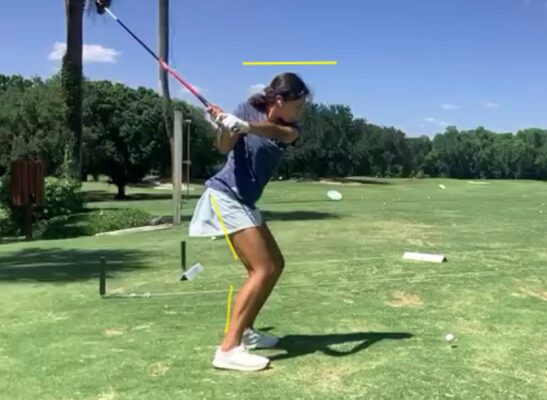
Every golfer wants more distance, and the key might be right under your feet. The vertical force in your golf swing—a dynamic up-down-up movement—can dramatically increase your clubhead speed and, consequently, your shot distance. The Jumping Principle Think of your golf swing like a vertical jump. Elite athletes and tour pros use a countermovement technique…
Every golfer wants more distance, and the key might be right under your feet. The vertical force in your golf swing—a dynamic up-down-up movement—can dramatically increase your clubhead speed and, consequently, your shot distance.
The Jumping Principle
Think of your golf swing like a vertical jump. Elite athletes and tour pros use a countermovement technique that primes the body for explosive power. This isn’t just about strength; it’s about timing, rhythm, and precise muscular engagement.
What Vertical Force Looks Like
At the transition point of the swing (moving from backswing to downswing), top players exhibit a subtle but crucial downward movement. This isn’t a sway or lateral slide, but a controlled lowering of the body’s center of mass. Imagine preparing to jump—you first dip down (unweighting the body) slightly before explosively extending upward. The three images below show a stick figure model of best PGA Tour players, an elite college player and an average handicap golfer. I placed lines on the head and the trail leg to show how vertical movement is a result of good lower body (legs and hip) movement
Figure Comparison: Vertical Force in Action
Stick Figure Model: Illustrates classic vertical movement mechanics
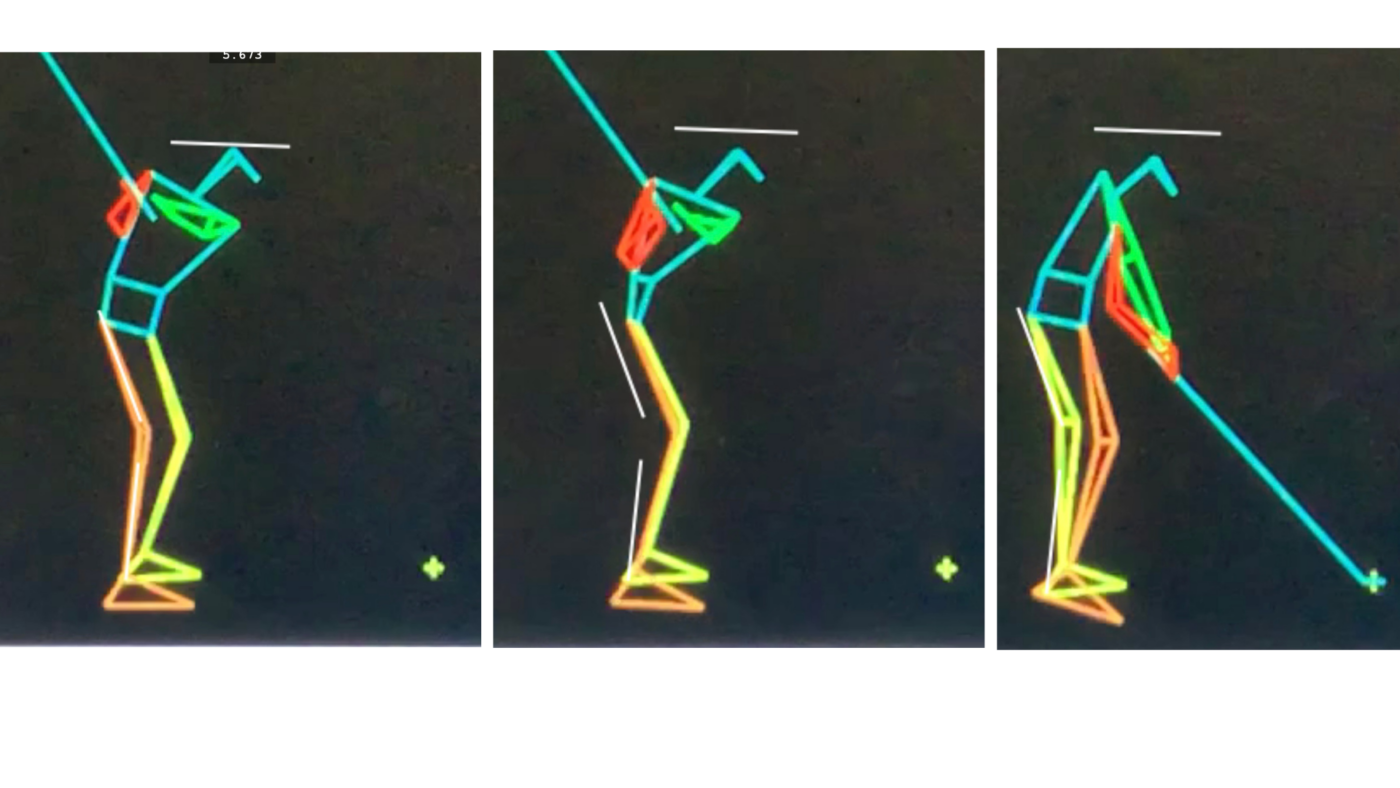
Elite College Player: Demonstrates precise, powerful vertical force technique
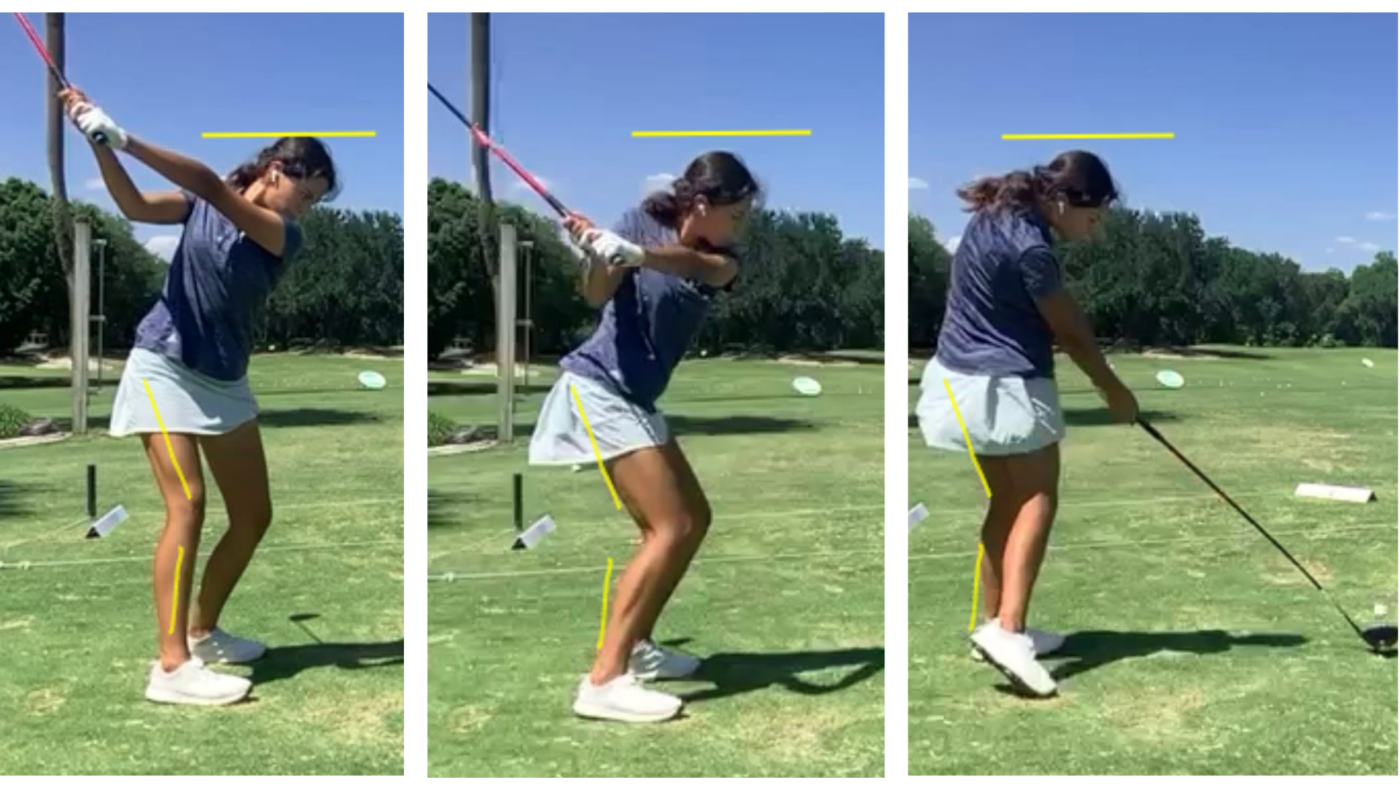
Amateur Golfer: Shows limited lower body engagement
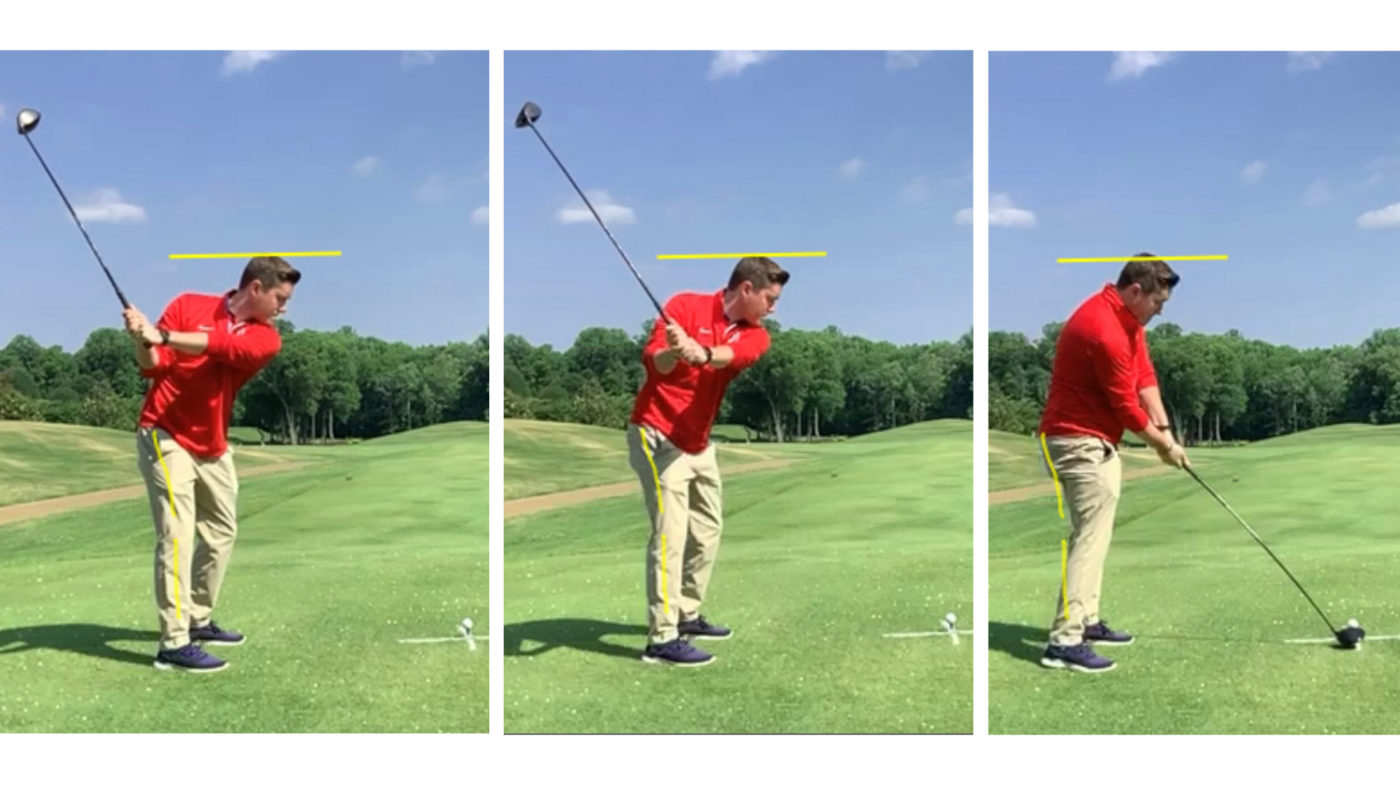
Pro vs. Amateur: The Vertical Movement Difference
How to Develop Vertical Force
Performance Benefit
Increasing vertical force isn’t just about power—it’s about efficiency. I use clubhead speed as an overall indicator of swing quality. In my experience, I have observed that as clubhead speed increases, shot accuracy often improves simultaneously.
Practice Tips
By understanding and implementing the vertical force principle, you’ll transform your golf swing from a mere arm-driven motion to a full-body, power-generating movement.
Remember: Distance isn’t about muscle—it’s about mechanics.
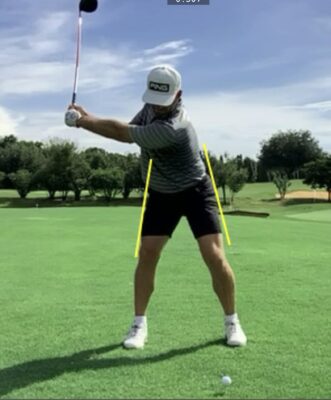
The start of the backswing is really a countermovement and involves two simple, whole-body movements. To begin the swing, you must shift your body laterally to the (right) trail leg, so you feel your weight transferring onto your trail leg and to the inside part of your trail foot. The movement is small but pronounced;…
The start of the backswing is really a countermovement and involves two simple, whole-body movements. To begin the swing, you must shift your body laterally to the (right) trail leg, so you feel your weight transferring onto your trail leg and to the inside part of your trail foot. The movement is small but pronounced; only about two inches. This happens early in the initial takeaway and is completed by the time the club is parallel to the ground. Although the initial part of the backswing is focused on getting weight transferred to the trail side, some turning of the hips and shoulders does occur.
This is why the initial shift must happen early, so you can then shift the emphasis on the second movement – the turning of the hips and shoulders. The timing of this shift then turn motion is subtle and it’s what gives the swing a fluid and effortless appearance. In the photos below, the professional golfer demonstrates the proper shift then turn movement pattern:
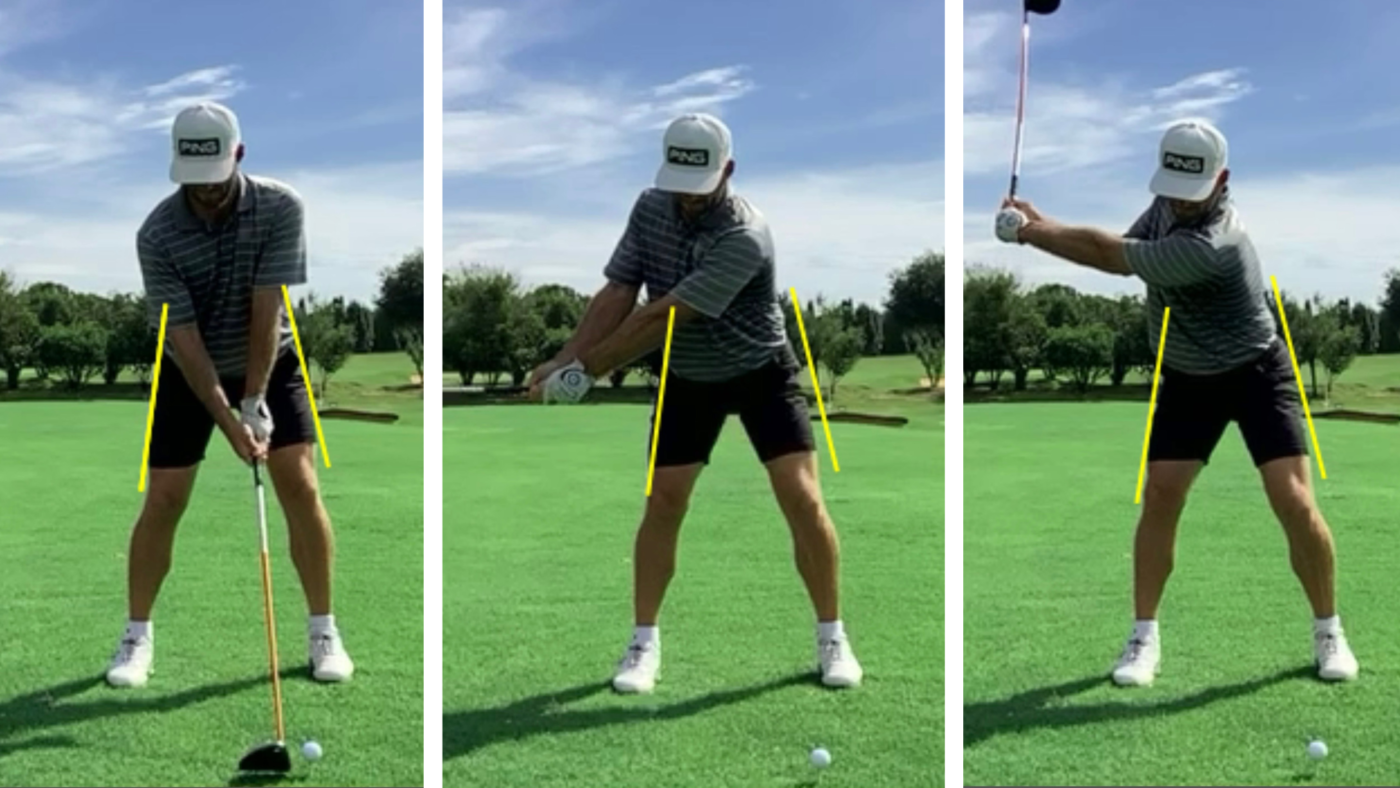
A very common fault among golfers is lingering over the ball in a static position and starting the swing with just the arms and no initial lateral shift. The student below demonstrates this improper no shift movement pattern:
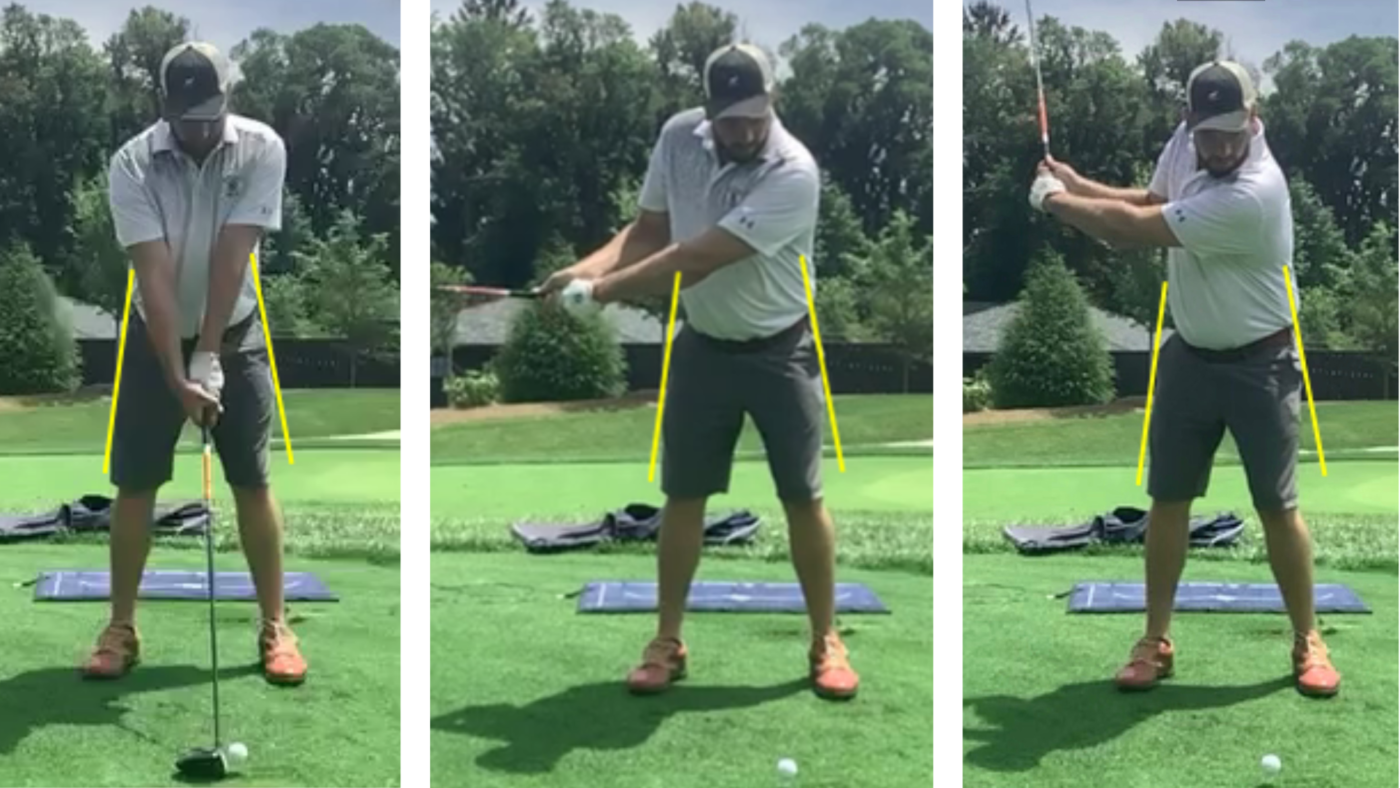
The other common fault among golfers is to start the lateral shift at the wrong time. They fail to incorporate the initial shift and when it’s time to start the turning component of the swing they continue to shift laterally, this is what I define as a sway. The student below demonstrates this improper no shift and sway movement pattern:
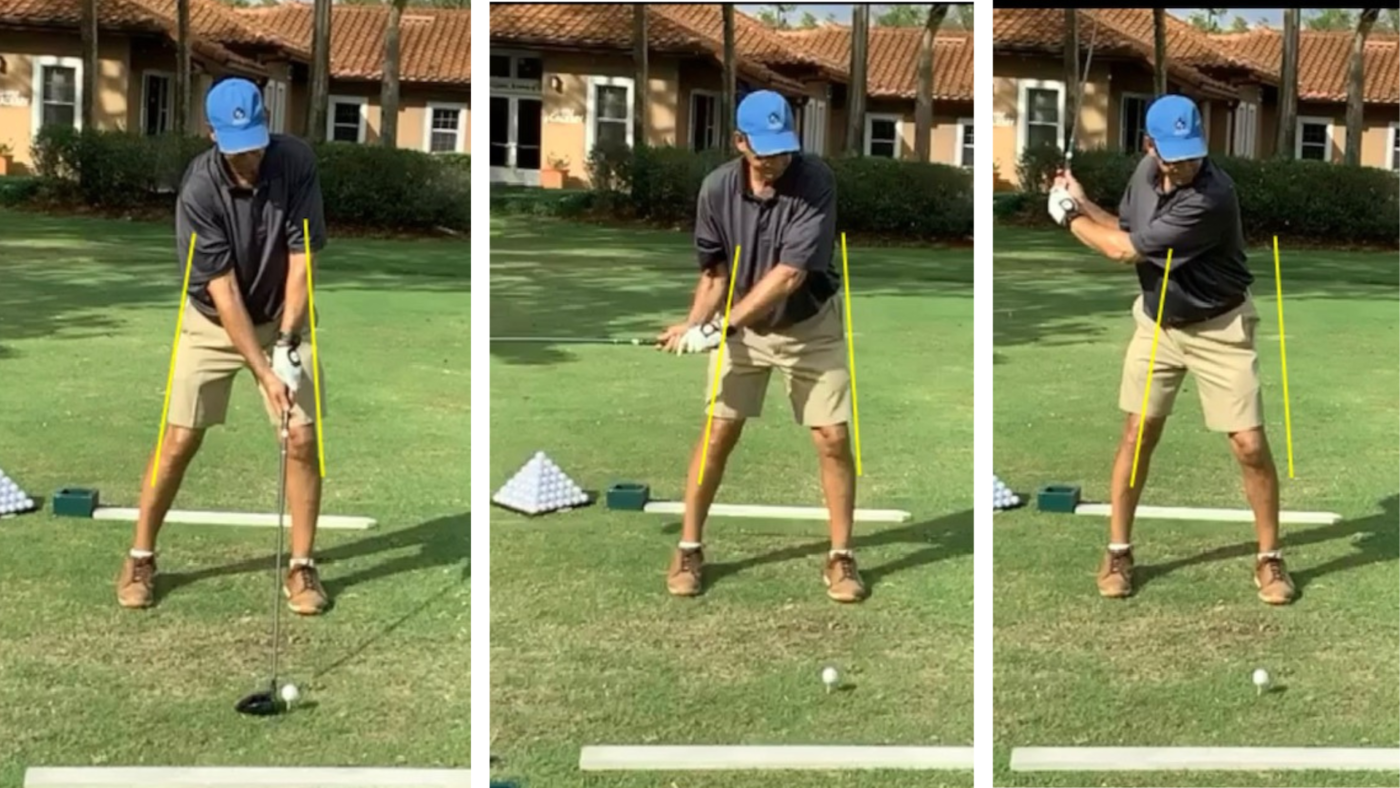
If, after the club is parallel to the ground, there is additional lateral movement away from the target this would be a sway. That’s a critical point because when you continue to shift, your weight would drift so far to the trail leg that you couldn’t recover and shift back to the lead leg at the proper time.
REMEMBER: Once the club has reached a point parallel to the ground in the backswing it’s time to shift the emphasis to turning the body. This is where most golfers fail commonly and instead of turning, they continue to shift laterally.
Lack of a proper body shift and turn sequence decreases distance of your shots because you never get in a position to use the power of the whole body. A sign of poor use of the shift and turn backswing sequence is a tendency to place the ball too far back in the stance to make solid contact. Your ability to perform the initial weight shift to the right, very early, well before the club becomes parallel to the ground, and then implement the body turn is the most challenging aspect of the backswing, and the part that warrants the most attention and practice.
Click here to watch a video that demonstrates the shift turn sequence and the importance of starting the swing with some type of motion, so the initial shift is a natural athletic motion.
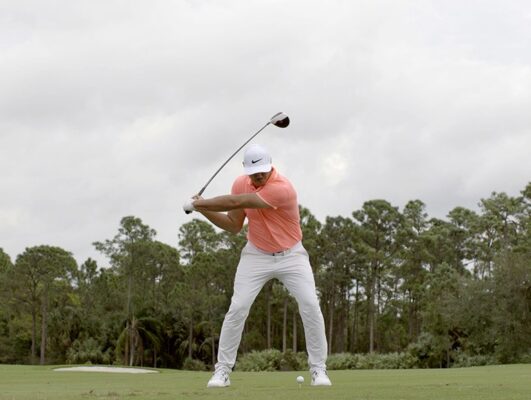
Developing a swing that produces a superb blend of distance and accuracy is what will ultimately result in a lower handicap. The longest and straightest golfers are PGA and LPGA tour players. They produce enormous distance and at the same time exhibit amazing precision with their shots. By improving your swing mechanics and making it…
Developing a swing that produces a superb blend of distance and accuracy is what will ultimately result in a lower handicap. The longest and straightest golfers are PGA and LPGA tour players. They produce enormous distance and at the same time exhibit amazing precision with their shots. By improving your swing mechanics and making it more efficient, you will enjoy the maximum distance you can achieve and hit the ball straighter as well.

These photos of Brooks Koepka are in the mid-downswing position many times referred to as P-5. This is a point in the swing where the elite golfer has demonstrated maximum force on the lead leg and the maximum angle between the left arm and clubshaft (left photo). In addition, the right heel is raised off the ground and the hips are rotated open to the target while the shoulders remain closed with the clubshaft bisecting the trail bicep assuring an inside swing path (right photo).
One of the common faults I encounter in my teaching is what I label the Upper-Body Dive. The correct sequence in the downswing is to lead with the lower body by generating power from the ground through the legs and hips. The upper body remains relatively stable and coiled creating a stretch between the lower body and the upper body and arms. This stores energy in the swing resulting in greater clubhead speed. The consequences of an upper-body dive will force the club to release too early (photo below) on the downswing-losing both the power of the lower body as well as the speed of the club. It prevents you from moving your trail side down and through the shot correctly.
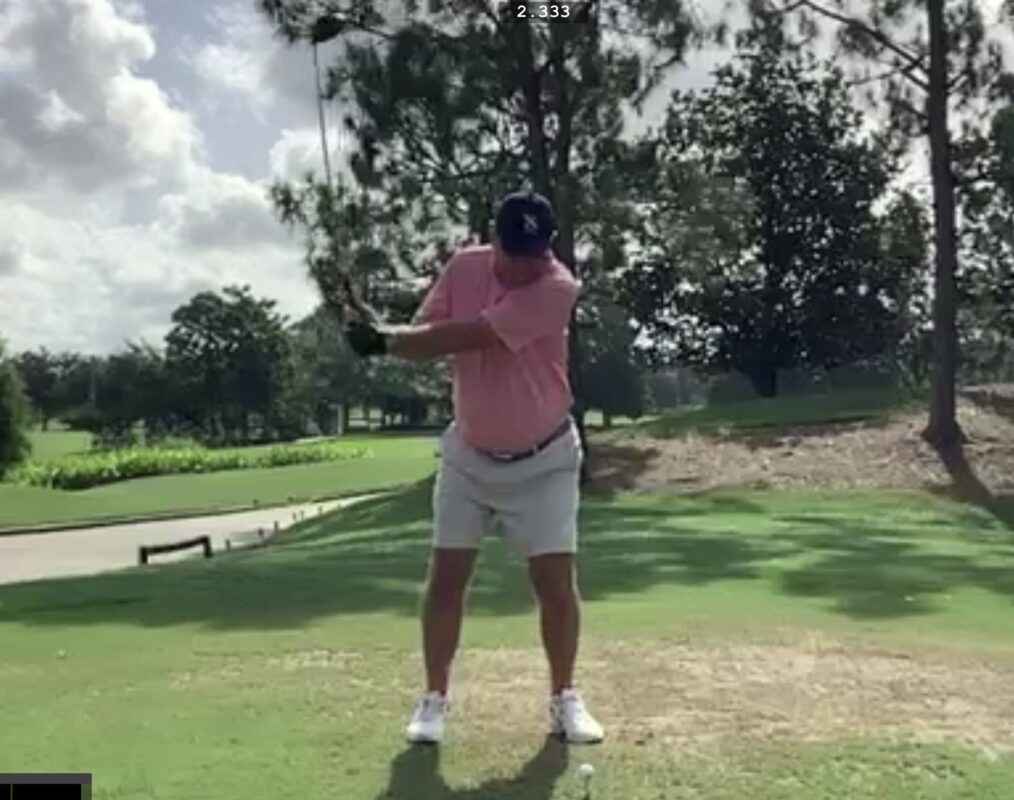
Looking at the swing from behind, or down the target line, the upper-body dive cost you accuracy as well. The limited use of the lower body shift and turn curbs your ability to channel the club into the ball along the proper swing path. The upper-body dive is one of the main causes of the “over the top” moves, which will result in a nasty pull or slice (photo below).
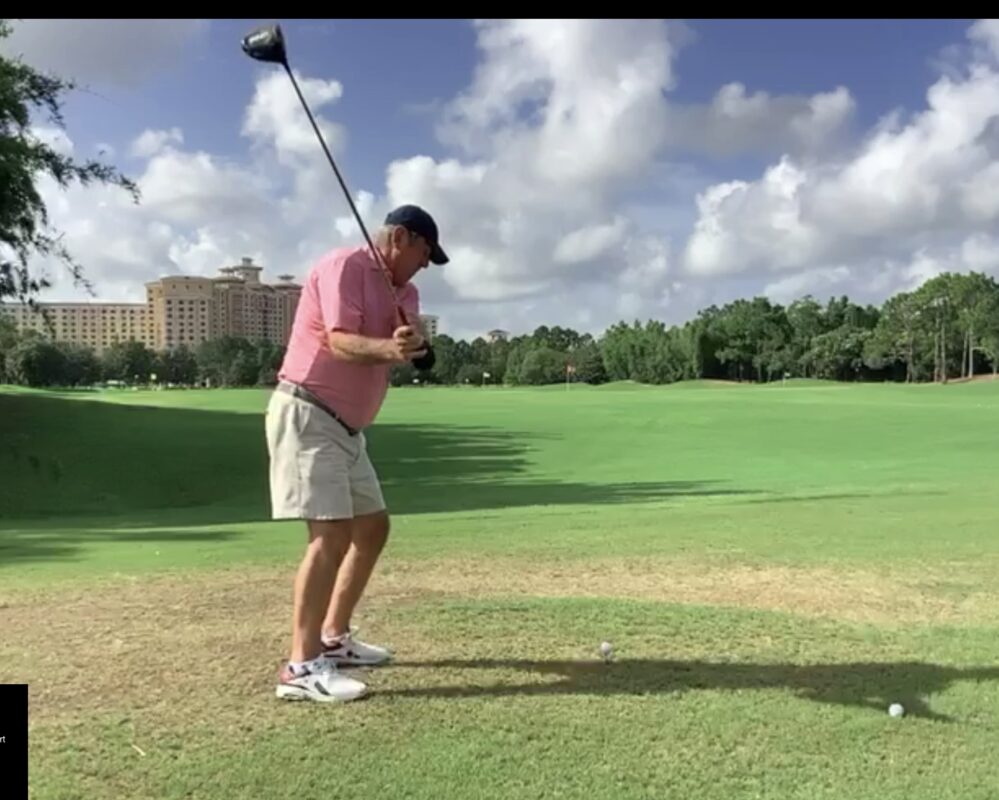
To see an instruction video on the Upper-Body Dive click here.
The two previous articles that will be helpful in avoiding the Upper-Body Dive are below:
A Blueprint for Longer Drives Off the Tee
Precision Perfected: Elevating Your Game Through Accurate Ball Striking
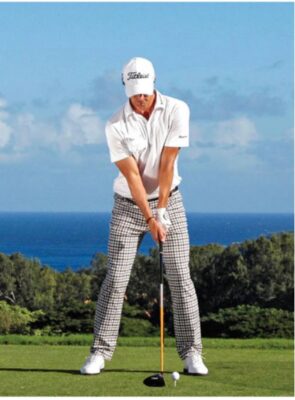
When I ask students to complete a pre-school questionnaire with their goals, the number one answer, hands down, is they would like to become more consistent with their ball striking. Most will say that they hit good shots from time to time, but they lack consistency. Their faulty swing mechanics are what is limiting their…
When I ask students to complete a pre-school questionnaire with their goals, the number one answer, hands down, is they would like to become more consistent with their ball striking. Most will say that they hit good shots from time to time, but they lack consistency. Their faulty swing mechanics are what is limiting their consistency, and this starts with compensating factors that are built into their set-up position. For example, a chronic slicer will align to the left of the target and strengthen the grip or close the clubface to reduce the slice. A golfer that casts or releases the club early will place the ball back in their stance to gain better contact, avoiding fat or thin shots.
The ability to position the body correctly at address serves several vital objectives that are at least as important as the swing itself. The quality of every movement in the swing is a byproduct of your set-up at address. Proper set-up creates the foundation for a consistent swing path, solid contact, and ultimately, better scores on the course. By focusing on your set-up, you can eliminate many compensations and bad habits that lead to inconsistent ball striking. This article will guide you through the essential aspects of setting up correctly and provide drills to help ingrain these fundamentals into your routine.
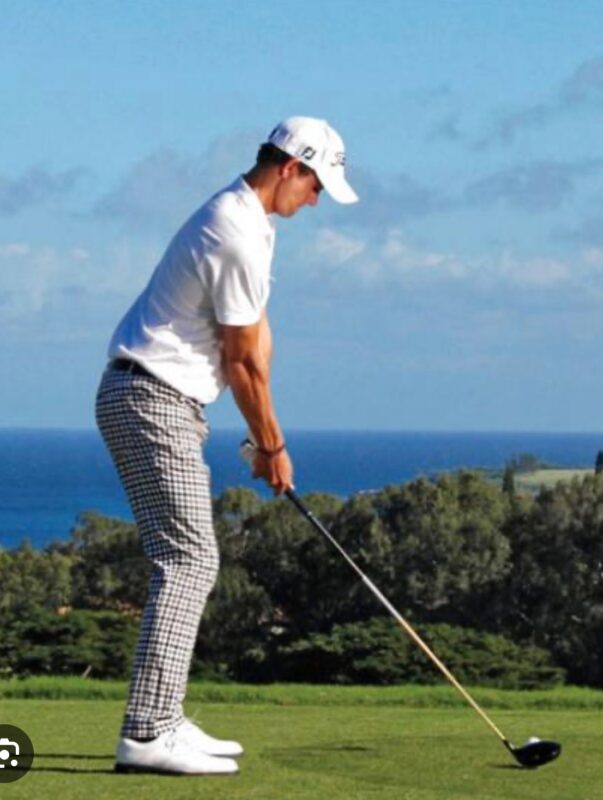
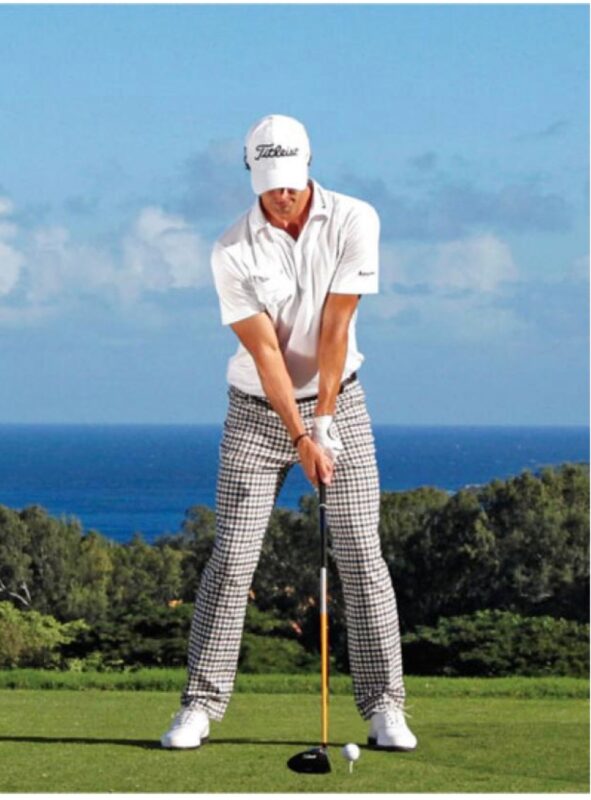
Whether viewed from down-the-target-line (left) or face-on (right), a good set up allows the golfer to look as if every shot will be powerful and straight.
Once the swing begins, your whole attention is focused on the task of striking the ball, and your body will do whatever is necessary to make it happen. Where you decide to place the ball on the ground in relation to your feet has an enormous influence on how your body reacts in your attempt to find the ball with the clubhead. If the ball is positioned correctly, you can swing the club freely without having to make compensations with your body.
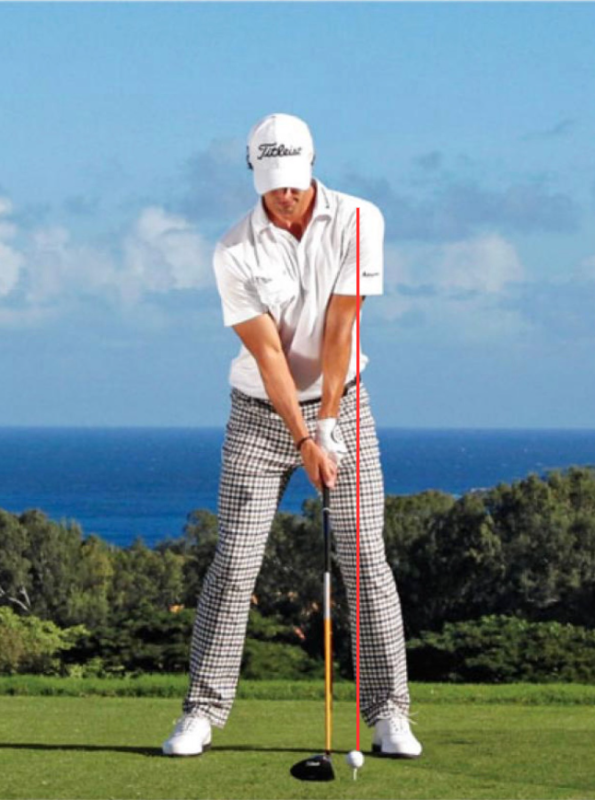
With the driver the ball is positioned opposite the left heel (notice the ball lines up with the left shoulder) and the ball moves back slightly as you progress to your irons. However, the ball position for the 9-iron is only moved three inches back from the driver position and the stance is narrowed.
The main issue from this view of the swing is golfers place the ball too far back in their stance at address. When the ball is positioned too far back in the stance, you can’t use the lower body effectively during the downswing. Placing the ball too far back in the stance necessitates a weak, arms only swing that lacks power. By training the correct ball position, your lower body will start contributing more to the swing and your ball contact and power will improve.
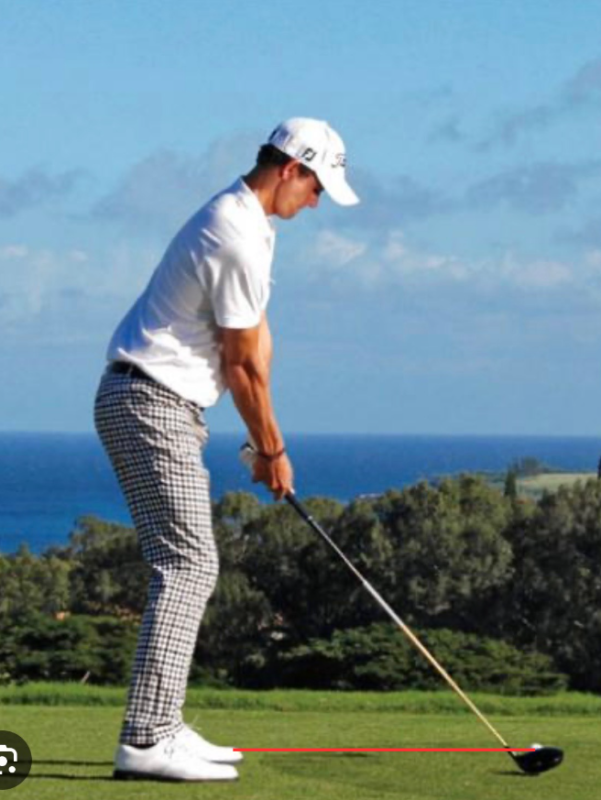
The proper distance away from the ball (toe-to-ball distance) is dictated mostly by the length of the club. This helps the golfer to establish the proper swing path during the swing. The range will vary slightly due to club length, swing style and body type but a general guide is the driver is 34-36 inches, the 5-iron is 22-24 inches and the 9 iron is 19-21 inches. Making it a point to stand the proper distance from the ball will allow the club to perform in the way it was designed.
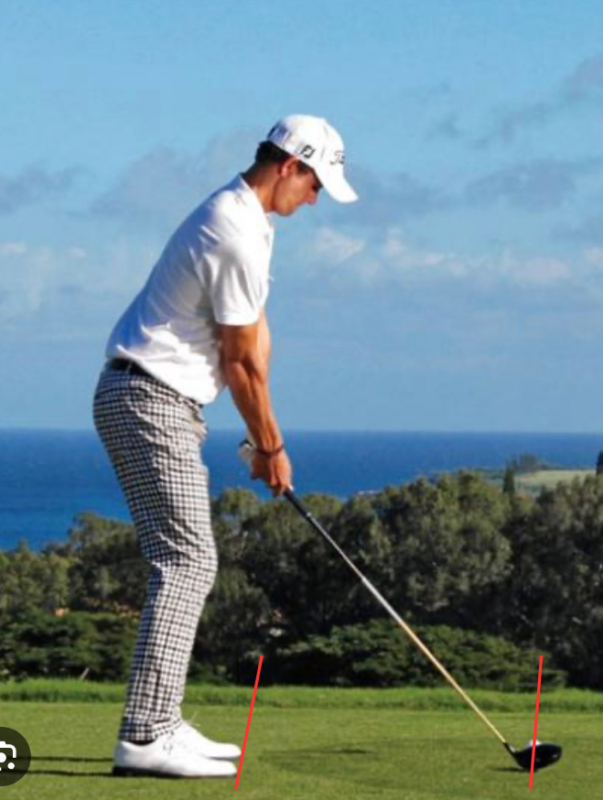
The feet are aligned parallel to slightly open relative to the target line. The left foot is turned out, toward the target, the right foot is positioned straighter and slightly forward of the left foot. Since the power of the swing comes from the big muscles, this alignment and foot position allows more contribution from the lower body. The better players have realized that, to apply maximum power, there must be emphasis on downswing shift and rotation.
In my experience teaching thousands of golfers, the same set up mistakes tend to occur repeatedly. A common one that is many times done on purpose is a closed stance alignment. It is usually prescribed as a slice cure, a counter to the outside-to-inside swing path that causes a slice. But aiming way to the right is a band aid cure and it creates more problems than it solves. Aiming to the right causes your backswing path to be dramatically more inside. My experience has been that the farther you swing inside on the backswing, the farther outside the you will swing in the downswing. This will be worsening your tendency to swing outside-to-inside. The closed stance limits the forward movement as well as the rotation of the lower body during the downswing. To compensate for this restriction, the upper body is normally used to bring the club around the body. Due to the decrement in swing quality and the restrictions placed on the lower body the resulting clubhead speed will also be lowered.
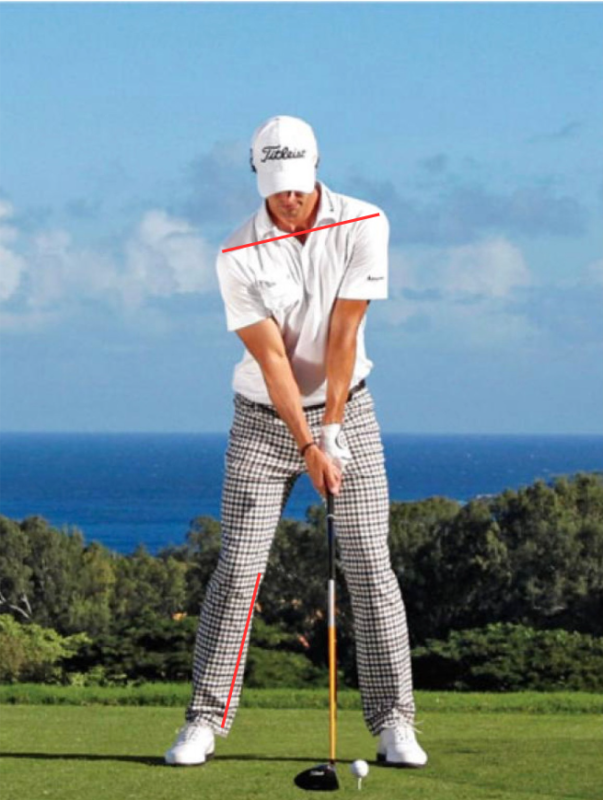
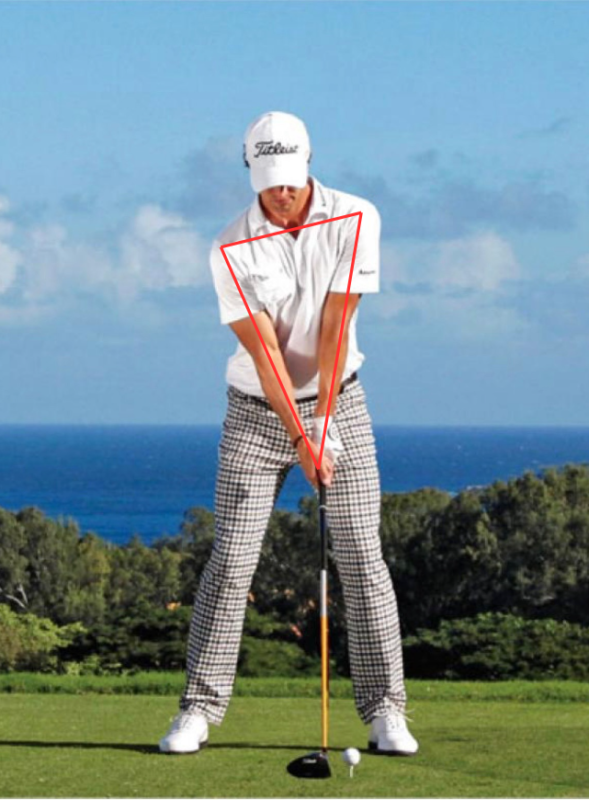
Other components to consider at set up include:
The right knee is angled inside the right ankle so it can control the natural tendency for the knee to move away from the target during the backswing.
The shoulders are tilted, or inclined, so the right shoulder is below the left shoulder. This allows for the proper placement of the right arm to reach across your body and join the left so that both hands, the club and the ball are opposite your left heel at address. A triangle is formed with the arms, and they merge together at a point just inside the center of the left leg. By placing the hands forward at set up, it becomes easier to return them to a forward position at impact.
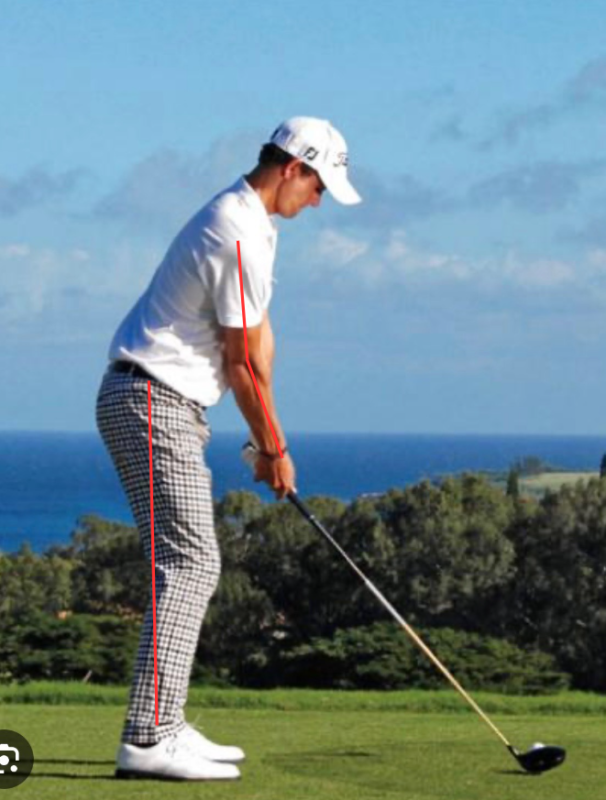
The right elbow is slightly flexed, while maintaining the left arm in a virtually straight position. This allows the left arm to be visible above the left.
The weight is positioned slightly towards the balls of the feet and distributed evenly between the two feet. This is the type of posture and balance you want to produce when executing a good set up for golf. A good checkpoint is the center of your hip should be positioned over your ankle joints.

In my January post, I talked about one of the crucial components that enhance accuracy. In this post, I will expound on another critical aspect of the swing that will help you find more fairways and greens. I mentioned how important it is to swing on the correct path (inside – square – inside) relative to…
In my January post, I talked about one of the crucial components that enhance accuracy. In this post, I will expound on another critical aspect of the swing that will help you find more fairways and greens.
I mentioned how important it is to swing on the correct path (inside – square – inside) relative to the target line, but another factor is controlling the proper “pitch” of the club. Pitch simply refers to the tilt of the club during the swing. During the move to the top, the pitch of the club is more toward vertical. In comparison, the pitch of the club is flatter on the downswing. The images below are Brooks Koepka with a driver and in his mid-backswing shaft “pitched” vertical and mid-downswing (top images) where the shaft is “pitched” flatter. In the (bottom images) I have added a line to reference the “pitch of the shaft related to the position of the ball. The image in the mid-backswing the line is pointed inside the ball and in the mid-downswing the line pointed just above, or outside the ball.
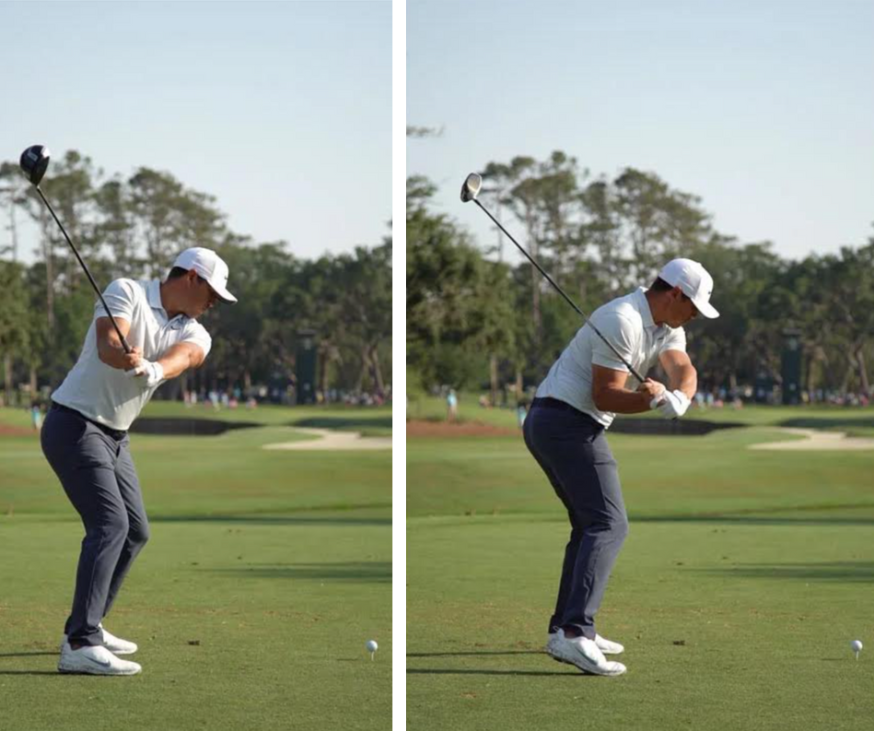
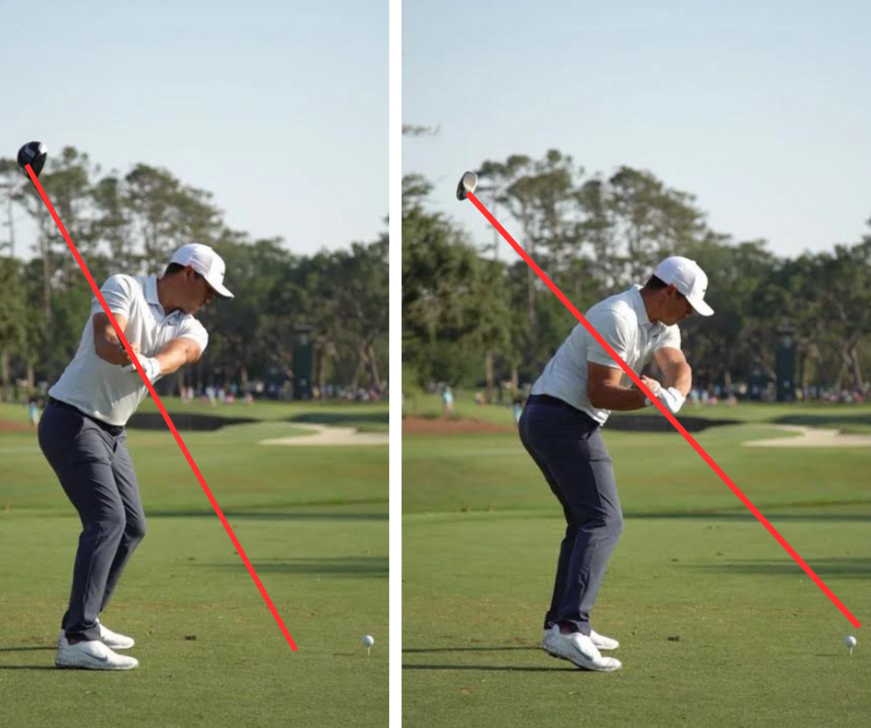
Brooks does so many good movements that contribute to his great ball striking ability and controlling the “pitch” of the club is one of his many attributes of his great swing.
This change in “pitch” of the club from the backswing to the downswing has been called many things in golf, from “flattening the shaft” to “shallowing the club.” Regardless of the choice of terms, it is a major contributor to a successful golf swing. This club movement begins as you arrive at the top of the backswing and continues early in the downswing. As with most critical movements in the golf swing “time matters” and the time when this club movement occurs is very important.
It ensures that the club will complete its journey to impact efficiently, automatically producing an inside path as well as helping to square the clubface.
To integrate the correct movement pattern and “pitch” of the club click on the link below to watch a demonstration of suggested drills you can work on at home or on the range.
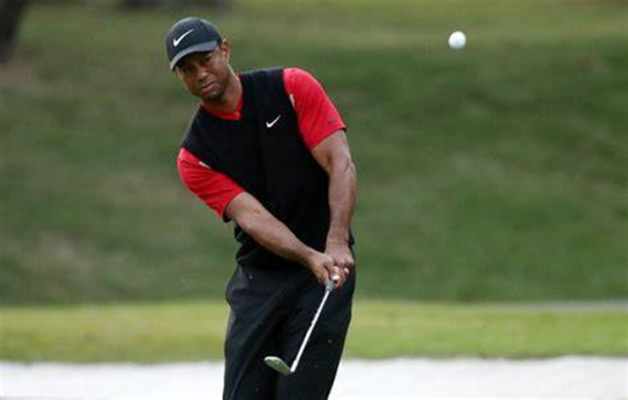
The Masters is the one golf event where I park myself in front of the television and watch the broadcast for five hours on Sunday afternoon. I started my professional career in Augusta as an assistant pro at West Lake Country Club. I have been fortunate to play Augusta National Golf Club on a couple…
The Masters is the one golf event where I park myself in front of the television and watch the broadcast for five hours on Sunday afternoon. I started my professional career in Augusta as an assistant pro at West Lake Country Club. I have been fortunate to play Augusta National Golf Club on a couple of occasions. In 2001, while working with Franklin Langham, I played with him a couple of weeks before the Masters and then joined him at the tournament where he finished T40.
Scottie Scheffler’s win was very impressive and especially given the windy conditions earlier in the week. In his press conference after the event, he contributed his win to his excellent driving and stroke saving short game. Driving distance is a big advantage at Augusta and combine that with an impeccable short game and you are almost certain to find yourself in contention.
While previous posts focused on improving driving and approach play, the short game deserves equal attention. If you have been following my tips, you’re probably familiar with the concept of Tiger 15 – a drill I incorporate into every lesson with my students. It’s a simple yet incredibly effective exercise that can drastically improve your short game skills. There is a video on You Tube of Tiger rolling a ball out in front of him approximately 15 yards and his first shot he lands the ball on top of the ball that’s 15 yards away. Now it’s your turn to give the Tiger 15 a try!

Contrary to the full swing’s power-driven nature, the short game hinges on power control. A proficient short game can salvage a round, turning a bad day into an okay one or a good round into a great one. It’s a myth that only pros excel here – with proper technique and practice, anyone can handle a wedge just as effectively.
The pros are good at the short game and one of the reasons is that they keep it simple. Based on years of research with Dr. Ralph Mann and myself we identified three factors to consider in the short game: solid contact, desired trajectory, and optimal distance.
Once you have decided on the shot and the swing begins, the main goal of the short game shot is to strike the ball cleanly. To insure this, place the ball in the middle of the stance, align the stance slightly open to the target, shift the weight slightly forward and place the hands in front of the ball at address. Not only does this help to get the hands in front of the ball at impact, but the open stance also automatically produces a more vertical or upright swing path. To further help increase the steepness of the swing, limit any shift away from the target during the backswing. Then make a whole-body transition, moving both the lower and upper body forward during the downswing. Unlike the full swing, both the upper and lower body are ahead of the set-up position when impact occurs. Besides the differences in setup and lack of body movement off the ball, the short game has many traits of the full swing. The short game involved the total body, with both hip and shoulder turn.
In the effort to keep the short game simple and repeatable, use the same swing mechanics and learn to alter the length, clubhead speed and club selection for trajectory and distance control. For example, on a 15-yard shot grip down a couple inches and narrow the stance, your swing length (arms) will be waist high (backswing) to waist high (follow through) with a slight wrist hinge. The clubhead speed is approximately 35 MPH. Use a more lofted club to a tight pin, and as the pin location is in the middle or back of the green choose a different loft and keep the swing the same. When the shot increases to 50 yards, grip the club in the normal position and move the feet wider, the swing length (arms) will be chest high (backswing) to chest high (follow through) and a bit more wrist hinge. The clubhead speed increases to 50 MPH.
The better players succeed in their short game shots because they make it simple. First, they account for most of the variation in the shots (distance and trajectory) before the swing begins by choosing the right club and grip length. Second, they set up to the ball to produce a steep vertical swing path, with the hands in front of the ball at impact. Finally, they keep the swing mechanics the same for all shots, varying only the length and speed of the swing to control distance.
The conditions that are encountered in the short game shots vary greatly. The situation that demands the greatest change in mechanics is the type of lie. If the lie is good, then no alterations are necessary. If the lie is poor, regardless of the reason, then the shot becomes more difficult. The best solution is to increase the steepness of the clubhead path to avoid the obstacle between the ball and the club (high grass, dirt, sand, etc.). One way to accomplish this would be to alter the swing to swing the club more dramatically up and down. Since this is too complex and dangerous, the better players choose a simpler method. They simply move the ball back in the stance and make the same swing they would use for a normal shot. The ball position guarantees a steeper angle and avoids the player from having to make complex swing changes. The short game has been made complicated by so many different opinions concluding that there are an infinite number of ways execute a good short game. In fact, the short game is based on simplicity. The simplicity is in keeping the swing mechanics the same and just deciding on swing length and club loft. Simple as that!
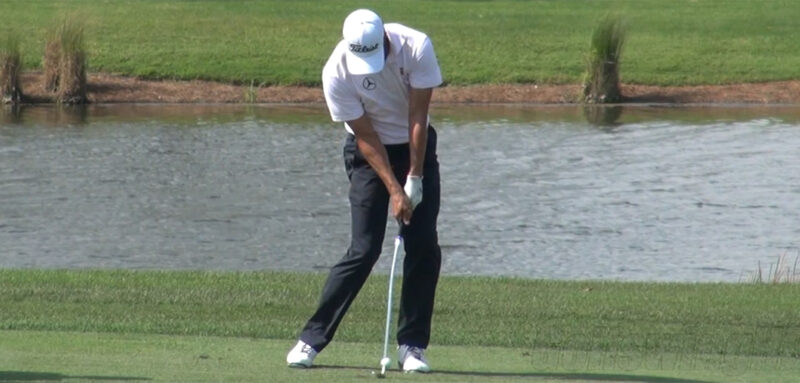
In this month’s blog, we’re exploring the importance of becoming a great iron player. A crucial aspect of the game that separates the good from great. I will start by highlighting some of the professionals known for their exceptional iron play. Take Jack Nicklaus, for example, whose legendary precision with irons has left a memorable…
In this month’s blog, we’re exploring the importance of becoming a great iron player. A crucial aspect of the game that separates the good from great. I will start by highlighting some of the professionals known for their exceptional iron play. Take Jack Nicklaus, for example, whose legendary precision with irons has left a memorable mark on the sport. Phil Rodgers, my longtime mentor, once remarked that Nicklaus hit almost every iron shot to exactly pin high-a testament to his exceptional ball striking and distance control.
Moving to the modern era, we can’t overlook Tiger Woods, widely regarded as one of the greatest, if not the greatest, golfers of all time. According to Mark Broadie’s “Every Shot Counts,” Woods excels in every aspect of the game, but it’s his approach play that truly sets him apart. His ability to consistently place approach shots close to the hole translates to a significant strokes gained advantage of 1.3 per round against his peers.
Similarly, Scottie Scheffler, the current world No. 1, has made an impact with his impressive iron play. Ranked first in greens in regulation (2022-2023 season) and equally impressive statistics in proximity to the hole and strokes gained, Scheffler’s performance underscores the importance of mastering the iron game.
“Broadie further emphasizes that superior performance in these approach shots requires an excellent repeatable swing in order to control the shot distance, direction, trajectory, and ball spin to stop the ball close to the hole from a range of lies in the fairway and rough.”
Now, let’s dive into a technical aspect of iron play: Spin Loft. Spin Loft refers to the difference between angle of attack (the vertical path of the clubhead at impact) and the dynamic loft (the loft the player delivers to the ball) at impact. In the illustration below, the blue arrow is the club’s angle of attack, and the red arrow is the dynamic loft. Understanding this concept is crucial because it directly affects ball compression, trajectory, and ultimately, the distance and control of your shots.
If a player delivers the club with an -8 angle of attack (hitting down on the ball) and 35 degrees of dynamic loft, the Spin Loft will be 43 degrees. Another player that delivers the same club with a -5 angle of attack (a shallower angle of attack) and 24 degrees of dynamic loft, the Spin Loft will be 29 degrees.

The image below on the left indicates an iron swing that produces a higher dynamic loft angle at impact which results in a higher Spin Loft. The hands at impact are located opposite the right leg. The image below on the right indicates an iron swing that produces a lower dynamic loft angle at impact which results in a lower Spin Loft. The hands at impact are located opposite the left leg.

So, how can you improve your Spin Loft and, by extension, your iron play? It starts with the lower body. By focusing on the dynamic movement of your lower body, particularly the shifting and turning of your hips toward the target, you can optimize your Spin Loft. This kinetic energy not only generates power but also helps position your body (shifted and turned toward the target) and club (hands in front of clubhead) for a solid impact. (See photos below from “Swing Like a Pro” book).
Additionally, pay attention to your grip position. A stronger than neutral grip position can help you better control the clubface through impact (when the hands move forward because of the lower body movement the clubface opens), ensuring that it remains square and delivers the optimal dynamic loft for your shot. This simple adjustment can make a significant difference in the consistency, accuracy, and trajectory of your iron play.

Notice the shift towards the target with the lower body. Also, the hands are positioned 5 inches ahead of their original set up position at impact. The hips have rotated open at impact. Notice the right heel is off the ground and the daylight between the legs.
In summary, mastering iron play is a combination of technical understanding and physical execution. By learning from the greats of the game, understanding concepts like spin loft, and refining your lower body movement and proper grip, you can elevate your iron game to new heights. So, embrace the challenge, and let’s work together to unlock your full potential on the course. Look forward to seeing you soon!